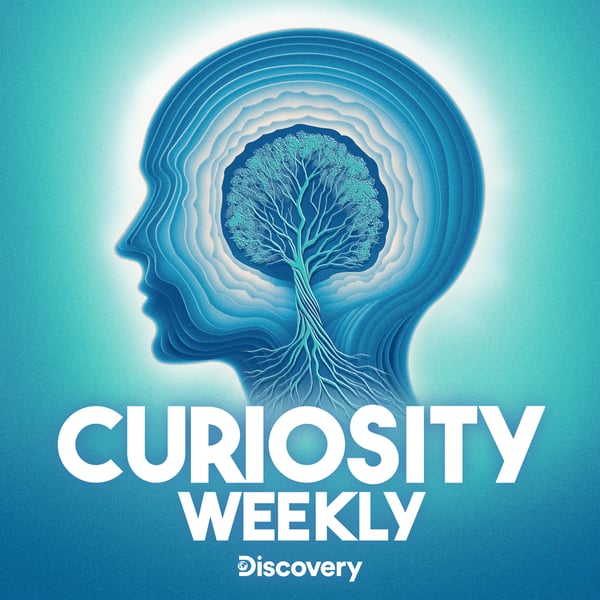Glow-in-the-Dark Cities, Feeling Holes, Max Volume on Earth
Curiosity Weekly
Warner Bros. Discovery
4.6 • 935 Ratings
🗓️ 2 March 2022
⏱️ 19 minutes
🧾️ Download transcript
Summary
Learn about glow-in-the-dark cities; why holes feel larger with a tongue than a finger; and the maximum volume on Earth.
Maybe we can save the planet by making our cities glow in the dark by Briana Brownell
- Kleiner, K. (2021, November). Will glow-in-the-dark materials someday light our cities? Knowable Magazine | Annual Reviews. https://knowablemagazine.org/article/technology/2021/will-glow-in-the-dark-materials-someday-light-our-cities
- Long Persistent Luminescence: A Road Map Toward Promising Future Developments in Energy and Environmental Science. (2021). Annual Review of Materials Research. https://www.annualreviews.org/doi/10.1146/annurev-matsci-091520-011838
Why holes feel larger with your tongue than with your finger by Grant Currin
- Why Do Holes Feel Larger With Your Tongue Than With Your Finger? (2017, November). Mentalfloss.com. https://www.mentalfloss.com/article/512813/why-do-holes-feel-larger-your-tongue-your-finger
- Seriously Science. (2017, October 18). Scientist finally figures out why holes feel larger with your tongue than with your finger. Discover Magazine; Discover Magazine. https://www.discovermagazine.com/health/scientist-finally-figures-out-why-holes-feel-larger-with-your-tongue-than-with-your-finger#.Wfn2exNSzm1
- Albashaireh, Z. S. M., & Orchardson, R. (1988). Comparison of the human perception of hole size by the tongue and the fingers. Archives of Oral Biology, 33(3), 183–185. https://doi.org/10.1016/0003-9969(88)90043-x
- Wilkins, A. (2010, December 28). Why our tongues and fingers “see” the world differently. Gizmodo; Gizmodo. https://gizmodo.com/why-our-tongues-and-fingers-see-the-world-differently-5719827
- Drewing, K. (2018). The extent of skin bending rather than action possibilities explains why holes feel larger with the tongue than with the finger. Journal of Experimental Psychology: Human Perception and Performance, 44(4), 535–550. https://doi.org/10.1037/xhp0000453
- S2E5: Head Transplants - Taboo Science Podcast. (2021). Tabooscience.show. https://www.tabooscience.show/s2e5-head-transplants/
There's a maximum sound volume on Earth by Cameron Duke
- EarQ. (2021). What Are Decibels (dB)? | Loudness Levels, Safe, Unsafe. Earq.com. https://www.earq.com/hearing-health/decibels
- Hearing loss and deafness: Normal hearing and impaired hearing. (2017, November 30). Nih.gov; Institute for Quality and Efficiency in Health Care (IQWiG). https://www.ncbi.nlm.nih.gov/books/NBK390300/
- Koerth, M. (2016, July 7). The Loudest Sound In The World Would Kill You On The Spot. FiveThirtyEight; FiveThirtyEight. https://fivethirtyeight.com/features/the-loudest-sound-in-the-world-would-kill-you-on-the-spot/
- Kolitz, D. (2019, January 14). What’s the Loudest Sound in the Universe? Gizmodo; Gizmodo. https://gizmodo.com/whats-the-loudest-sound-in-the-universe-1831720066
- Mihai Andrei. (2020, February 4). The loudest sound in mankind’s history. ZME Science; ZME Science. https://www.zmescience.com/science/the-loudest-sound-ever-in-mankinds-history/
Follow host Cody Gough on Giveo and at https://academicpodcasts.com. Still curious? Get exclusive science shows, nature documentaries, and more real-life entertainment on discovery+! Go to https://discoveryplus.com/curiosity to start your 7-day free trial. discovery+ is currently only available for US subscribers.
Hosted on Acast. See acast.com/privacy for more information.
Transcript
Click on a timestamp to play from that location
| 0:00.0 | Hi, you're about to get smarter in just a few minutes with Curiosity Daily from Discovery. |
| 0:06.4 | I'm Cody Gough. |
| 0:07.8 | And today you learn about how we could save the planets by making our cities glow in the dark, why holes feel larger with your tongue than with |
| 0:16.0 | your finger, and the maximum sound volume on Earth. |
| 0:20.5 | Let's satisfy some curiosity. Imagine walking around your neighborhood at night, |
| 0:26.0 | but instead of bright street lights, the streets are filled with soft ambient light |
| 0:32.0 | glowing from buildings and sidewalks and roads. |
| 0:35.4 | It might seem like a stretch but a group of scientists is developing a series of new |
| 0:40.7 | materials that could light our cities at night using |
| 0:45.1 | luminescent materials rather than light sources. Now this is not just |
| 0:51.1 | about aesthetics although what look cool it's also good for energy efficiency. |
| 0:56.0 | Lighting is responsible for about 20% of global energy use. |
| 1:01.0 | Reducing that energy usage would go a long way in helping combat climate change. |
| 1:06.0 | The scientists have been studying luminescent materials for over four centuries. |
| 1:12.0 | Instead of emitting heat immediately, these materials trap the energy of photons that hit it and then re-emmit them later as visible light. |
| 1:22.0 | The first luminescent material was created later as visible light. |
| 1:22.8 | The first luminescent material was created in 1603 by Vincenzo Castrolo, when he smelted some stones |
| 1:31.5 | he found on Mount Paderno Italy and found they would glow after being exposed to sunlight. |
| 1:38.0 | And since then, scientists have found lots of other luminescent materials. |
| 1:42.0 | There are 250 that we know of. have found lots of other luminescent materials. |
| 1:42.9 | There are 250 that we know of, |
| 1:45.4 | and most of the materials glow, blue or green, |
... |
Please login to see the full transcript.
Disclaimer: The podcast and artwork embedded on this page are from Warner Bros. Discovery, and are the property of its owner and not affiliated with or endorsed by Tapesearch.
Generated transcripts are the property of Warner Bros. Discovery and are distributed freely under the Fair Use doctrine. Transcripts generated by Tapesearch are not guaranteed to be accurate.
Copyright © Tapesearch 2025.

